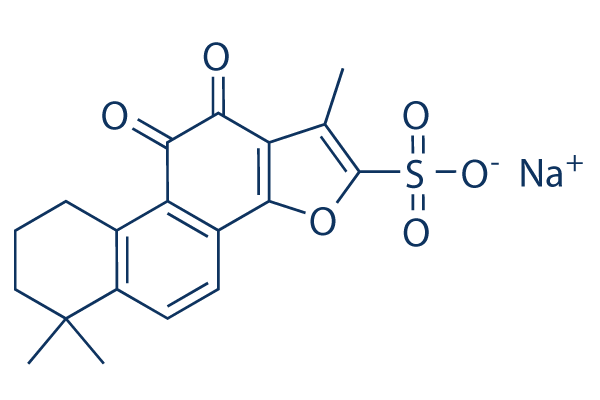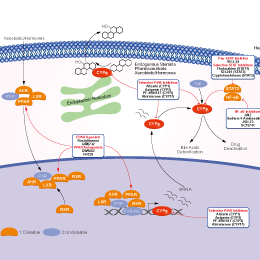
- Bioactive Compounds
- By Signaling Pathways
- PI3K/Akt/mTOR
- Epigenetics
- Methylation
- Immunology & Inflammation
- Protein Tyrosine Kinase
- Angiogenesis
- Apoptosis
- Autophagy
- ER stress & UPR
- JAK/STAT
- MAPK
- Cytoskeletal Signaling
- Cell Cycle
- TGF-beta/Smad
- Compound Libraries
- Popular Compound Libraries
- Customize Library
- Clinical and FDA-approved Related
- Bioactive Compound Libraries
- Inhibitor Related
- Natural Product Related
- Metabolism Related
- Cell Death Related
- By Signaling Pathway
- By Disease
- Anti-infection and Antiviral Related
- Neuronal and Immunology Related
- Fragment and Covalent Related
- FDA-approved Drug Library
- FDA-approved & Passed Phase I Drug Library
- Preclinical/Clinical Compound Library
- Bioactive Compound Library-I
- Bioactive Compound Library-Ⅱ
- Kinase Inhibitor Library
- Express-Pick Library
- Natural Product Library
- Human Endogenous Metabolite Compound Library
- Alkaloid Compound LibraryNew
- Angiogenesis Related compound Library
- Anti-Aging Compound Library
- Anti-alzheimer Disease Compound Library
- Antibiotics compound Library
- Anti-cancer Compound Library
- Anti-cancer Compound Library-Ⅱ
- Anti-cancer Metabolism Compound Library
- Anti-Cardiovascular Disease Compound Library
- Anti-diabetic Compound Library
- Anti-infection Compound Library
- Antioxidant Compound Library
- Anti-parasitic Compound Library
- Antiviral Compound Library
- Apoptosis Compound Library
- Autophagy Compound Library
- Calcium Channel Blocker LibraryNew
- Cambridge Cancer Compound Library
- Carbohydrate Metabolism Compound LibraryNew
- Cell Cycle compound library
- CNS-Penetrant Compound Library
- Covalent Inhibitor Library
- Cytokine Inhibitor LibraryNew
- Cytoskeletal Signaling Pathway Compound Library
- DNA Damage/DNA Repair compound Library
- Drug-like Compound Library
- Endoplasmic Reticulum Stress Compound Library
- Epigenetics Compound Library
- Exosome Secretion Related Compound LibraryNew
- FDA-approved Anticancer Drug LibraryNew
- Ferroptosis Compound Library
- Flavonoid Compound Library
- Fragment Library
- Glutamine Metabolism Compound Library
- Glycolysis Compound Library
- GPCR Compound Library
- Gut Microbial Metabolite Library
- HIF-1 Signaling Pathway Compound Library
- Highly Selective Inhibitor Library
- Histone modification compound library
- HTS Library for Drug Discovery
- Human Hormone Related Compound LibraryNew
- Human Transcription Factor Compound LibraryNew
- Immunology/Inflammation Compound Library
- Inhibitor Library
- Ion Channel Ligand Library
- JAK/STAT compound library
- Lipid Metabolism Compound LibraryNew
- Macrocyclic Compound Library
- MAPK Inhibitor Library
- Medicine Food Homology Compound Library
- Metabolism Compound Library
- Methylation Compound Library
- Mouse Metabolite Compound LibraryNew
- Natural Organic Compound Library
- Neuronal Signaling Compound Library
- NF-κB Signaling Compound Library
- Nucleoside Analogue Library
- Obesity Compound Library
- Oxidative Stress Compound LibraryNew
- Plant Extract Library
- Phenotypic Screening Library
- PI3K/Akt Inhibitor Library
- Protease Inhibitor Library
- Protein-protein Interaction Inhibitor Library
- Pyroptosis Compound Library
- Small Molecule Immuno-Oncology Compound Library
- Mitochondria-Targeted Compound LibraryNew
- Stem Cell Differentiation Compound LibraryNew
- Stem Cell Signaling Compound Library
- Natural Phenol Compound LibraryNew
- Natural Terpenoid Compound LibraryNew
- TGF-beta/Smad compound library
- Traditional Chinese Medicine Library
- Tyrosine Kinase Inhibitor Library
- Ubiquitination Compound Library
-
Cherry Picking
You can personalize your library with chemicals from within Selleck's inventory. Build the right library for your research endeavors by choosing from compounds in all of our available libraries.
Please contact us at [email protected] to customize your library.
You could select:
- Antibodies
- Bioreagents
- qPCR
- 2x SYBR Green qPCR Master Mix
- 2x SYBR Green qPCR Master Mix(Low ROX)
- 2x SYBR Green qPCR Master Mix(High ROX)
- Protein Assay
- Protein A/G Magnetic Beads for IP
- Anti-Flag magnetic beads
- Anti-Flag Affinity Gel
- Anti-Myc magnetic beads
- Anti-HA magnetic beads
- Poly FLAG Peptide lyophilized powder
- Protease Inhibitor Cocktail
- Protease Inhibitor Cocktail (EDTA-Free, 100X in DMSO)
- Phosphatase Inhibitor Cocktail (2 Tubes, 100X)
- Cell Biology
- Cell Counting Kit-8 (CCK-8)
- Animal Experiment
- Mouse Direct PCR Kit (For Genotyping)
- New Products
- Contact Us
Tanshinone IIA sulfonate sodium
Sodium tanshinone IIA sulfonate (STS) is a water-soluble derivative of tanshinone IIA isolated as the main pharmacologically active natural compound from a traditional Chinese herbal medicine, the dried root of Salvia miltiorrhiza Bunge known as Danshen. Sodium tanshinone IIA sulfonate (STS) is a potent negative allosteric modulator of the human purinergic receptor P2X7. Sodium tanshinone IIA sulfonate (STS) inhibits the activity of CYP3A4 and store-operated Ca2+ entry (SOCE) through store-operated Ca2+ channels (SOCC) via downregulating the expression of transient receptor potential canonical proteins (TRPC).

Tanshinone IIA sulfonate sodium Chemical Structure
CAS: 69659-80-9
Selleck's Tanshinone IIA sulfonate sodium has been cited by 1 publication
Purity & Quality Control
Batch:
Purity:
98.61%
98.61
Tanshinone IIA sulfonate sodium Related Products
| Related Targets | P450 CYP2 CYP51 CYP3 CYP735 CYP11 CYP26 CYP2C9 CYP1 CYP17 | Click to Expand |
|---|---|---|
| Related Compound Libraries | Metabolism Compound Library Anti-cancer Metabolism Compound Library Glutamine Metabolism Compound Library Carbohydrate Metabolism Compound Library Lipid Metabolism Compound Library | Click to Expand |
Signaling Pathway
Choose Selective P450 (e.g. CYP17) Inhibitors
Biological Activity
| Description | Sodium tanshinone IIA sulfonate (STS) is a water-soluble derivative of tanshinone IIA isolated as the main pharmacologically active natural compound from a traditional Chinese herbal medicine, the dried root of Salvia miltiorrhiza Bunge known as Danshen. Sodium tanshinone IIA sulfonate (STS) is a potent negative allosteric modulator of the human purinergic receptor P2X7. Sodium tanshinone IIA sulfonate (STS) inhibits the activity of CYP3A4 and store-operated Ca2+ entry (SOCE) through store-operated Ca2+ channels (SOCC) via downregulating the expression of transient receptor potential canonical proteins (TRPC). | ||||||
|---|---|---|---|---|---|---|---|
| Targets |
|
| In vitro | ||||
| In vitro | Sodium tanshinone IIA sulfonate (STS) inhibits the activity of CYP3A4 in a dose-dependent manner in the HLMs and CYP3A4 isoform. Other CYP isoforms, including CYP1A2, CYP2A6, CYP2C9, CYP2D6, CYP2E1, and CYP2C19, show minimal or no effect on the metabolism of STS. Thus, STS is a potent inhibitor for CYP3A4[1]. STS upregulates the protein expression of Bcl-2 and downregulates the proteins expression of Bax and Caspase-3[2]. Sodium tanshinone IIA sulfonate (STS) inhibits store-operated Ca2+ entry (SOCE) through store-operated Ca2+ channels (SOCC) via downregulating the expression of transient receptor potential canonical proteins (TRPC). STS treatment can effectively prevent the hypoxia-mediated inhibition of the PKG-PPAR-γ signaling axis in rat distal pulmonary arterial smooth muscle cells (PASMCs) and distal pulmonary arteries. It can also prevent hypoxia-mediated increases in intracellular calcium homeostasis and cell proliferation, by targeting and restoring the hypoxia-inhibited PKG-PPAR-γ signaling pathway in PASMCs[3]. |
|||
|---|---|---|---|---|
| Cell Research | Cell lines | pulmonary arterial smooth muscle cells (PASMCs) | ||
| Concentrations | 12.5 μM | |||
| Incubation Time | 60 h | |||
| Method | Rat PASMCs are digested by collagenase and then cultured in low-sugar DMEM medium containing 10% fetal bovine serum. When the fusion of cells is at 60-70%, the medium is replaced with the low-sugar DMEM medium containing 0.5% fetal bovine serum in which cells are cultured for 24 h to be homogenized. After the cells are grown to ∼80%, they are randomly divided into four groups, two of which are treated with STS (12.5 μM). STS group and STS-free group are randomly exposed to normoxic environment and hypoxic conditions (4% O2, 60 h). 60 h of prolonged hypoxic stress (4% O2) can effectively lead to elevated proliferation and migration of primary cultured distal PASMCs. This mimics similar hypoxic responses as the PASMCs isolated from the CHPH rats, as the hypoxic elevation of [Ca2+]i, SOCE, and upregulation of TRPC expression in cultured PASMCs only occur at 60 h or later time points of hypoxic exposure. In this study, both incubators are set to 37°C, 5% CO2. The total protein of these cells is extracted by RIPA buffer. |
|||
| In Vivo | ||
| In vivo |
The metabolic rate of Sodium tanshinone IIA sulfonate (STS) in rats is fast, the T1/2 is not more than 0.9 h[1]. tanshinone IIA has been reported to possess neuroprotective effects against Alzheimer’s disease (AD). STS decreases the activity of acetylcholinesterase (AChE) and increases the activity of choline acetyltransferase (ChAT) in the hippocampus and cortex of SCOP-treated mice. It increases the activity of superoxide dismutase (SOD) and decreases the levels of malondialdehyde (MDA) and reactive oxygen species (ROS) in hippocampus and cortex. STS administration (10 mg/kg and 20 mg/kg) could improve SCOP-induced learning and memory impairment in Kunming mice. Meanwhile, STS could obviously improve central cholinergic neurotransmission and attenuate oxidative damage. STS has cardioprotective effects on cardiovascular injury[2]. STS has been clinically used for decades in the treatment of numerous cardiovascular diseases, such as hypertension, atherosclerosis, and others[3]. |
|
|---|---|---|
| Animal Research | Animal Models | Kunming mice |
| Dosages | 10 mg/kg and 20 mg/kg | |
| Administration | oral administration | |
Chemical Information & Solubility
| Molecular Weight | 396.39 | Formula | C19H17O6S.Na |
| CAS No. | 69659-80-9 | SDF | Download Tanshinone IIA sulfonate sodium SDF |
| Smiles | CC1=C(OC2=C1C(=O)C(=O)C3=C2C=CC4=C3CCCC4(C)C)S(=O)(=O)[O-].[Na+] | ||
| Storage (From the date of receipt) | |||
|
In vitro |
DMSO : 79 mg/mL ( (199.29 mM); Moisture-absorbing DMSO reduces solubility. Please use fresh DMSO.) Water : 10 mg/mL Ethanol : 4 mg/mL |
Molecular Weight Calculator |
|
In vivo Add solvents to the product individually and in order. |
In vivo Formulation Calculator |
||||
Preparing Stock Solutions
Molarity Calculator
In vivo Formulation Calculator (Clear solution)
Step 1: Enter information below (Recommended: An additional animal making an allowance for loss during the experiment)
mg/kg
g
μL
Step 2: Enter the in vivo formulation (This is only the calculator, not formulation. Please contact us first if there is no in vivo formulation at the solubility Section.)
% DMSO
%
% Tween 80
% ddH2O
%DMSO
%
Calculation results:
Working concentration: mg/ml;
Method for preparing DMSO master liquid: mg drug pre-dissolved in μL DMSO ( Master liquid concentration mg/mL, Please contact us first if the concentration exceeds the DMSO solubility of the batch of drug. )
Method for preparing in vivo formulation: Take μL DMSO master liquid, next addμL PEG300, mix and clarify, next addμL Tween 80, mix and clarify, next add μL ddH2O, mix and clarify.
Method for preparing in vivo formulation: Take μL DMSO master liquid, next add μL Corn oil, mix and clarify.
Note: 1. Please make sure the liquid is clear before adding the next solvent.
2. Be sure to add the solvent(s) in order. You must ensure that the solution obtained, in the previous addition, is a clear solution before proceeding to add the next solvent. Physical methods such
as vortex, ultrasound or hot water bath can be used to aid dissolving.
Tech Support
Answers to questions you may have can be found in the inhibitor handling instructions. Topics include how to prepare stock solutions, how to store inhibitors, and issues that need special attention for cell-based assays and animal experiments.
Tel: +1-832-582-8158 Ext:3
If you have any other enquiries, please leave a message.
* Indicates a Required Field
Tags: buy Tanshinone IIA sulfonate sodium | Tanshinone IIA sulfonate sodium supplier | purchase Tanshinone IIA sulfonate sodium | Tanshinone IIA sulfonate sodium cost | Tanshinone IIA sulfonate sodium manufacturer | order Tanshinone IIA sulfonate sodium | Tanshinone IIA sulfonate sodium distributor








































